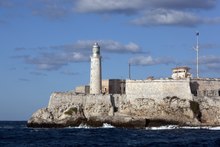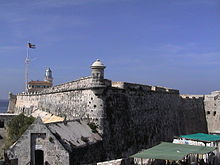Morro Castle (Havana)


Morro Castle (Spanish: Castillo de los Tres Reyes Magos del Morro), named after the three biblical Magi, is a fortress guarding the entrance to Havana bay in Havana, Cuba. The design was drawn up by the Italian engineer Battista Antonelli; originally under the control of Spain, the fortress was captured by the British in 1762, and was returned to the Spanish under treaty terms a year later.[1]
The Morro fortress in Havana shares its name with Castillo de San Pedro de la Roca in Santiago de Cuba and the Castillo de San Felipe del Morro in San Juan, Puerto Rico. In this case, the Spanish "morro" means a rock which is very visible from the sea and therefore serves as a navigational landmark.[2] Perched on the promontory on the opposite side of the harbor from Old Havana, it can be viewed from miles around as it dominates the port entrance. Built initially in 1589 in response to raids on Havana harbor, el Morro protected the mouth of the harbor with a chain being strung out across the water to the fort at La Punta. The fortress is part of the Old Havana World Heritage Site, inscribed in 1982 for its historical importance in the European conquest of the New World and its unique mix of architecture.[3]
Seven Years War[]

It first saw action in 1762, while under the command of Luis Vicente de Velasco e Isla. The British expedition against Cuba under Lord Albemarle landed in Cojimar to the east of Havana and attacked the fortress from its landward side. The fort fell when the British successfully mined one of its bastions. When the British handed the island back in 1763 to Spain, the fortress at La Cabaña was built to prevent this from happening again.
Exhibition[]
Inside the gates is an exhibition on the lighthouses of Cuba – El Morro once housed a school for lighthouse keepers. There was actually a watchtower here until the British blew it up during their successful siege in 1762. The Faro Castillo del Morro lighthouse was added in 1846.
The cannons around the fort are now badly rusted, but the walls are well preserved. The fort has central barracks up to four stories high. A small underwater archeology exhibition is also located here. Noteworthy are the old latrines and their chute into the sea, as are the two sets of doors and the drawbridge mechanism. The current harbor master's office is still housed in the fortress. A plaque dedicated by the ambassador of the United Kingdom commemorates the 1762 siege, and a small memorial is located between two strong powder rooms in the northeast bastion.
A small turret at the end of the wall offers views of the sea crashing onto the rocks 20 meters below, and of the huge dry moat. The opposite side of the moat holds more modern guns and cannons, La Bateria de Velasco, and offers a sweeping view down to Cojimar.
El cañonazo de las 9[]
The complex is now part of a historical park, along with the El Morro fortress, and houses several museums open to the public. Every night a cannon is fired at 9pm, the so-called "El Cañonazo de las 9" is a leftover custom kept from colonial times signaling the closure of the city gates.
Appearances in culture[]
Art[]
Morro Castle can be seen in the background of John Singleton Copley's oil painting Watson and the Shark (1778).
Film[]
Morro Castle appears in the movie The Ghost Breakers (1940), in the background as Bob Hope and Paulette Goddard enter the harbor by ship.
The climactic scenes from The Big Boodle (1957) starring Errol Flynn were shot at Morro Castle in pre-Castro Cuba.
During his life, the Castro regime imprisoned the Cuban poet and novelist Reinaldo Arenas (1943-1990) at El Morro Castle for criticism of the government. The film version of Arenas's autobiography, Before Night Falls (2000), starring Javier Bardem, features scenes set in El Morro Castle prison. (A fortress in Mexico City doubled for the prison, since the filmmakers were not allowed to film in Cuba.)
Publications[]
The Cuban writer José Antonio Echeverría (1815-1885) published his only novel, Antonelli (1839), in the periodical La Cartera Cubana in three parts.[4] An historical novel in the tradition of Walter Scott, Antonelli describes the love triangle among Antonelli, a Spanish soldier, and the planter's daughter they both love. Morro Castle is the setting for many of the book's events, including its tragic finale.
Gallery[]

Castle of los Tres Reyes del Morro

Cargo ship passing the El Morro fortress.

Inside the El Morro fortress.

Inside the El Morro fortress.

The Morro Castle at night

Havana Bay, c. 1639. by Johannes Vingboons
Panoramica Castillo de los Tres Reyes Magos del Morro.
References[]
| Wikimedia Commons has media related to Morro Castle. |
- ^ "Castillo de los Tres Reyes Magos del Morro in Havana – Cuba". Tourist Spots Around the World. Retrieved 2011-09-09.
- ^ "Morro: Monte o peñasco escarpado que sirve de marca a los navegantes en la costa".
- ^ "Old Havana and its Fortification System". UNESCO World Heritage Centre. United Nations Educational, Scientific, and Cultural Organization. Retrieved 26 May 2021.
- ^ Cairo, Ana. Prologue. Antonelli. La Habana: Editorial Letras Cubanas, 2005. 5-12.
Coordinates: 23°09′01.67″N 82°21′23.99″W / 23.1504639°N 82.3566639°W
- Infrastructure completed in 1589
- Fortifications of Havana
- Tourist attractions in Havana
- Spanish colonial fortifications in Cuba
- Castles in Cuba







